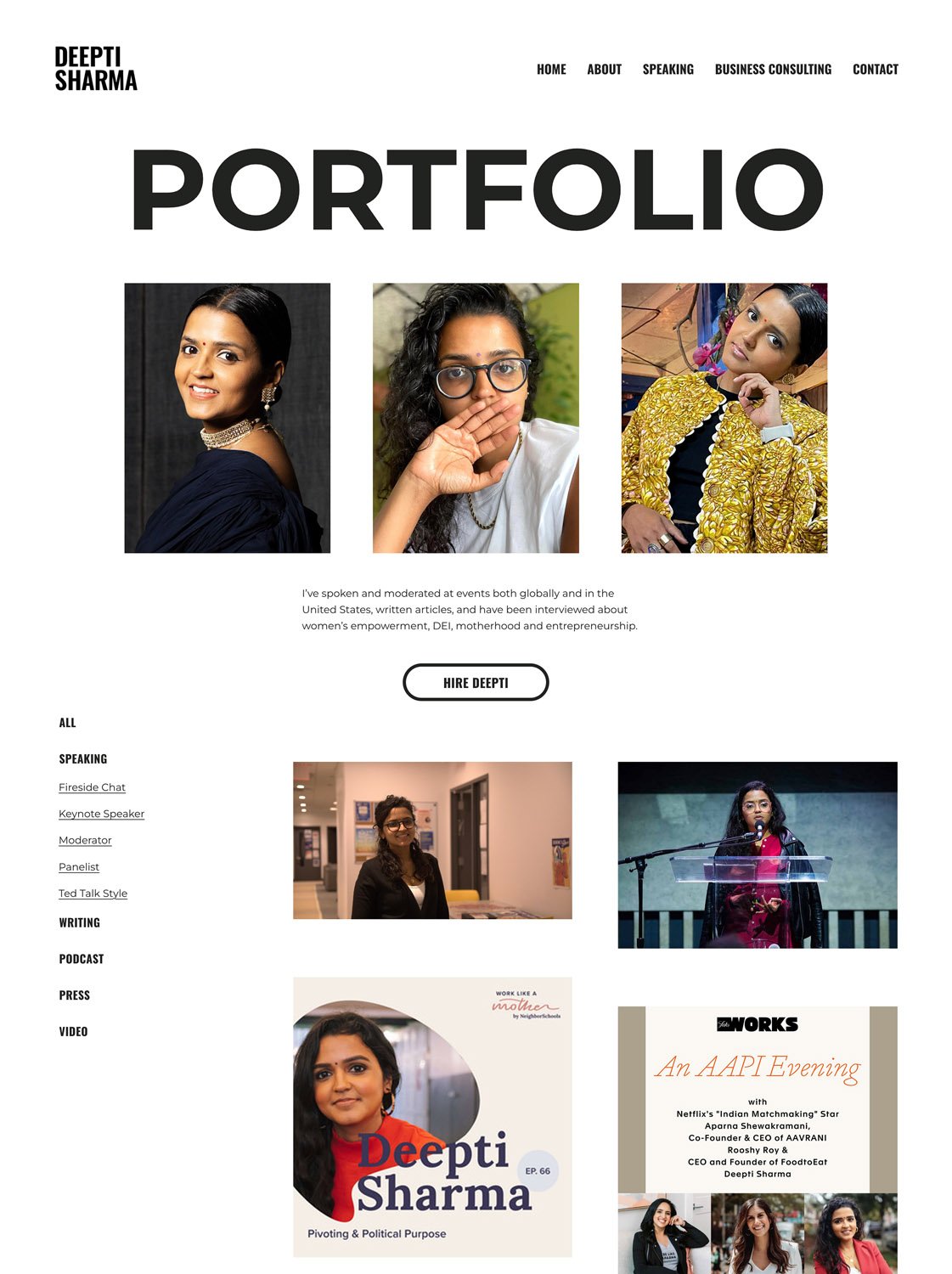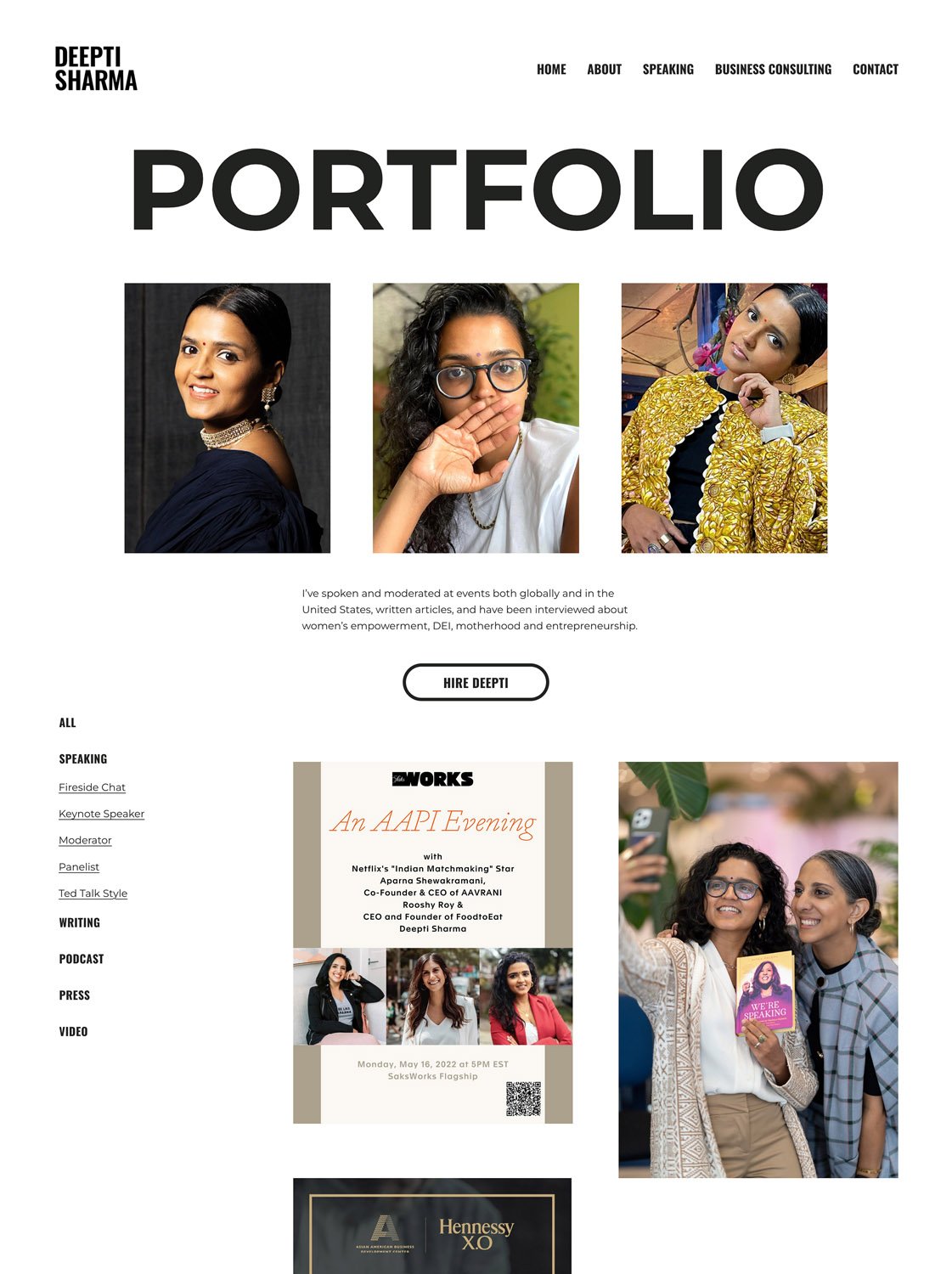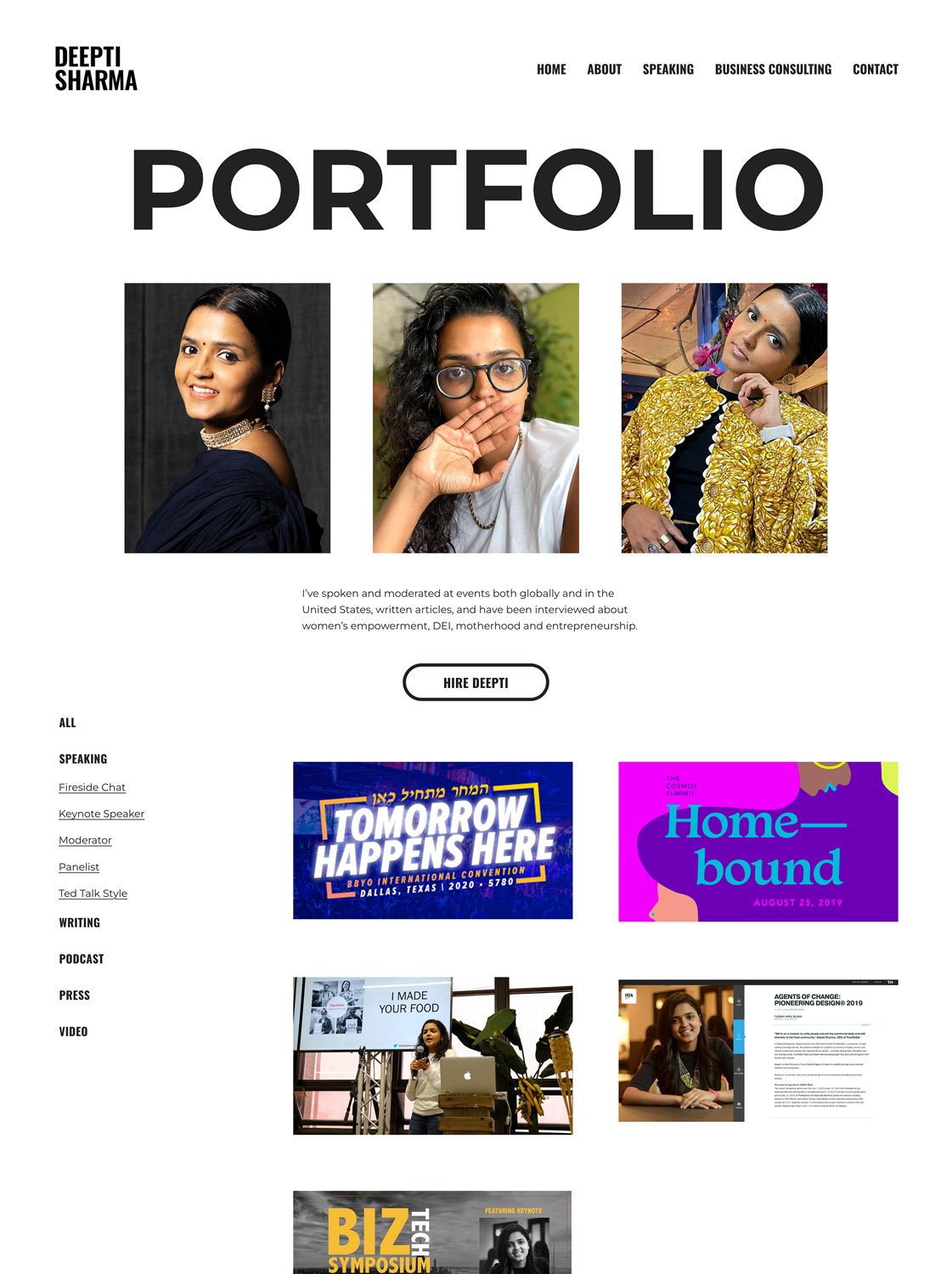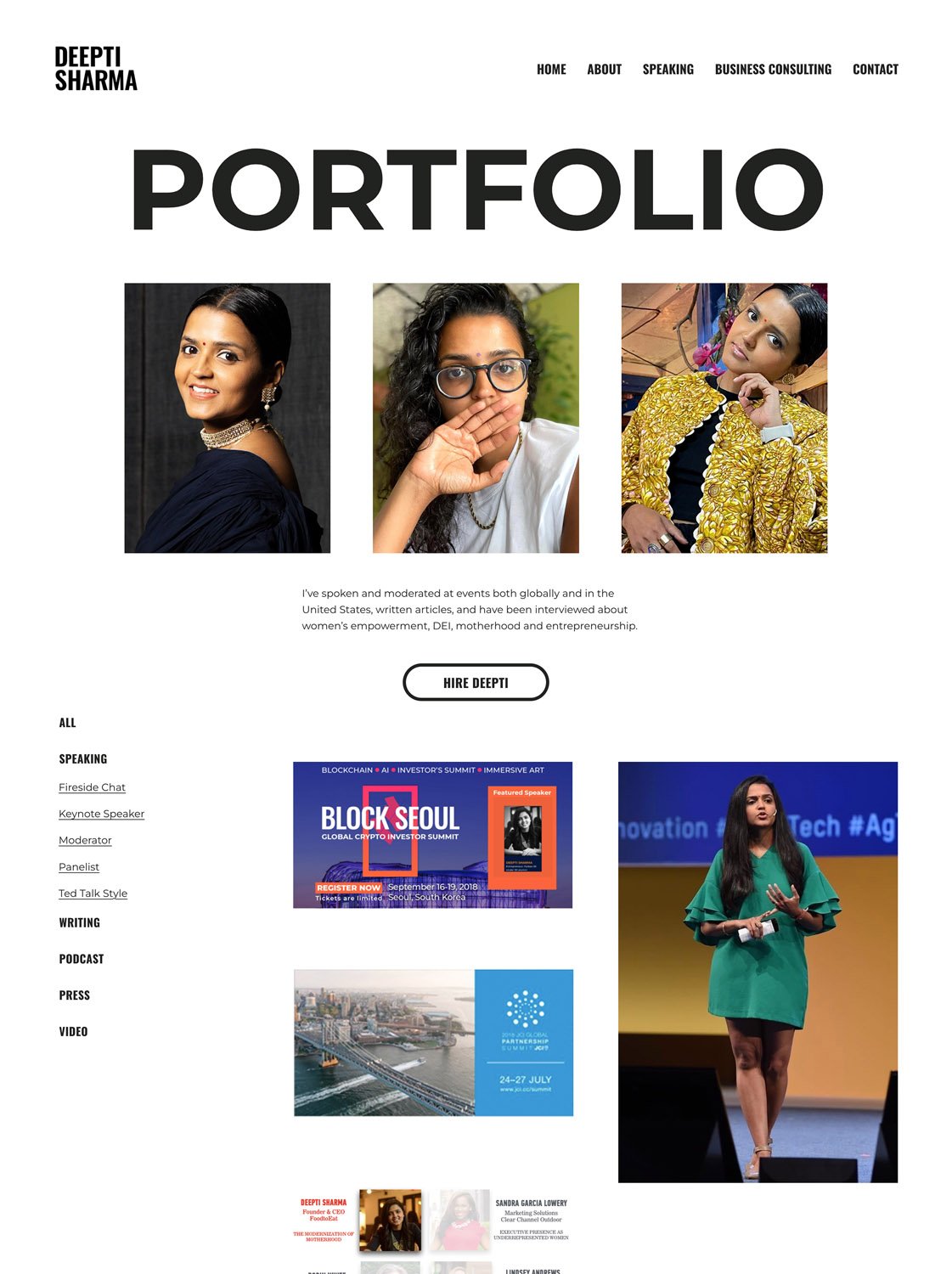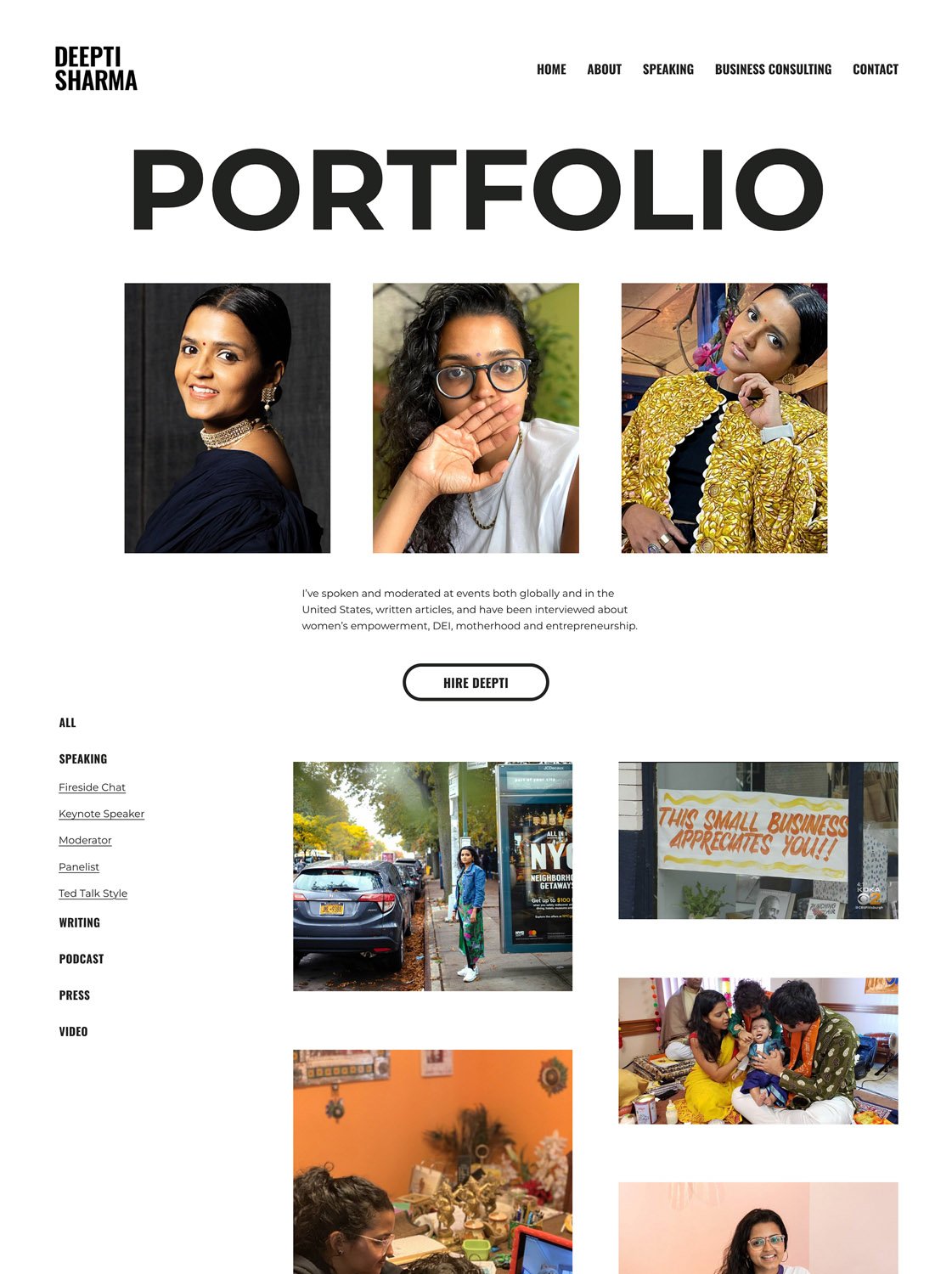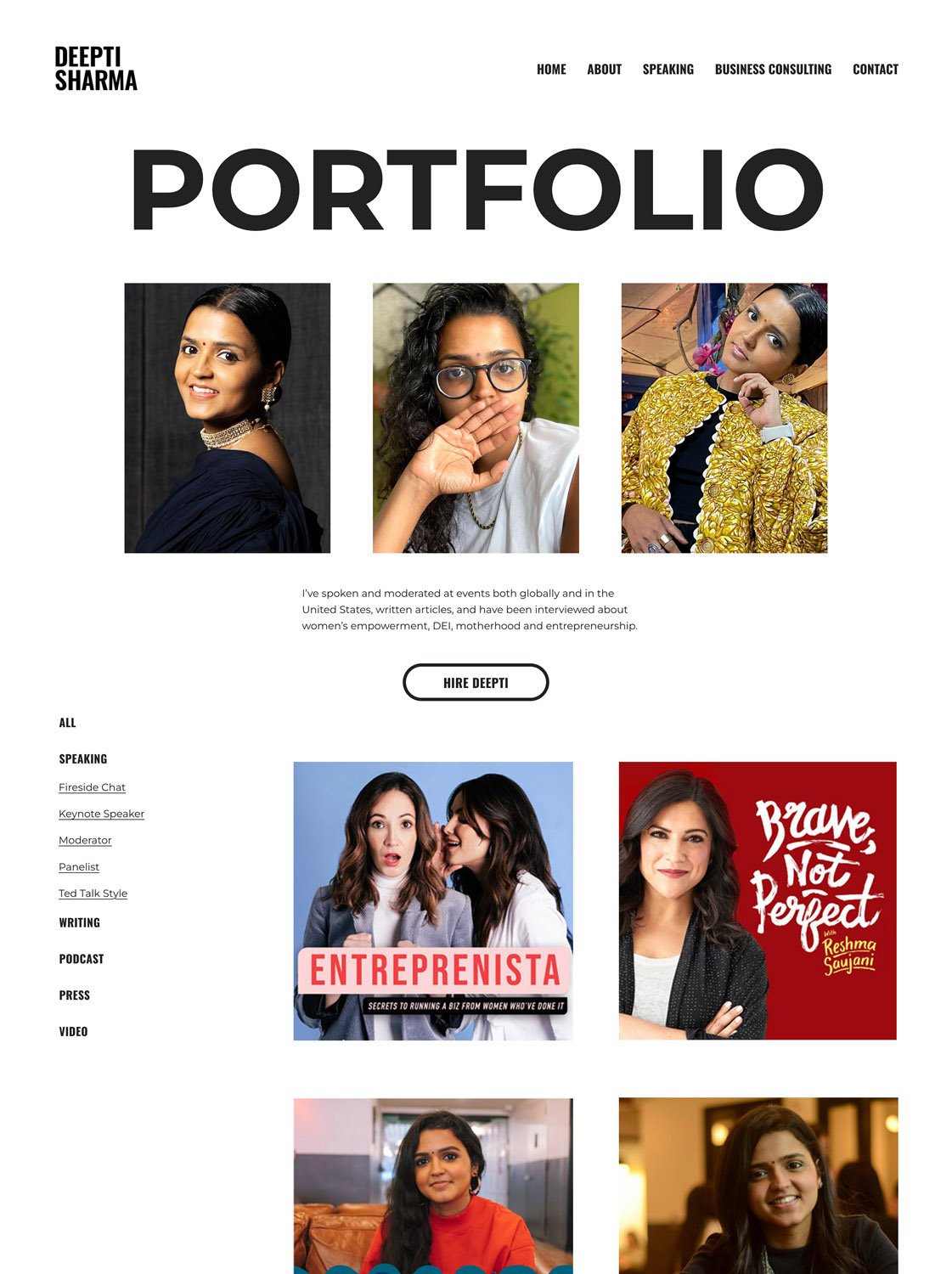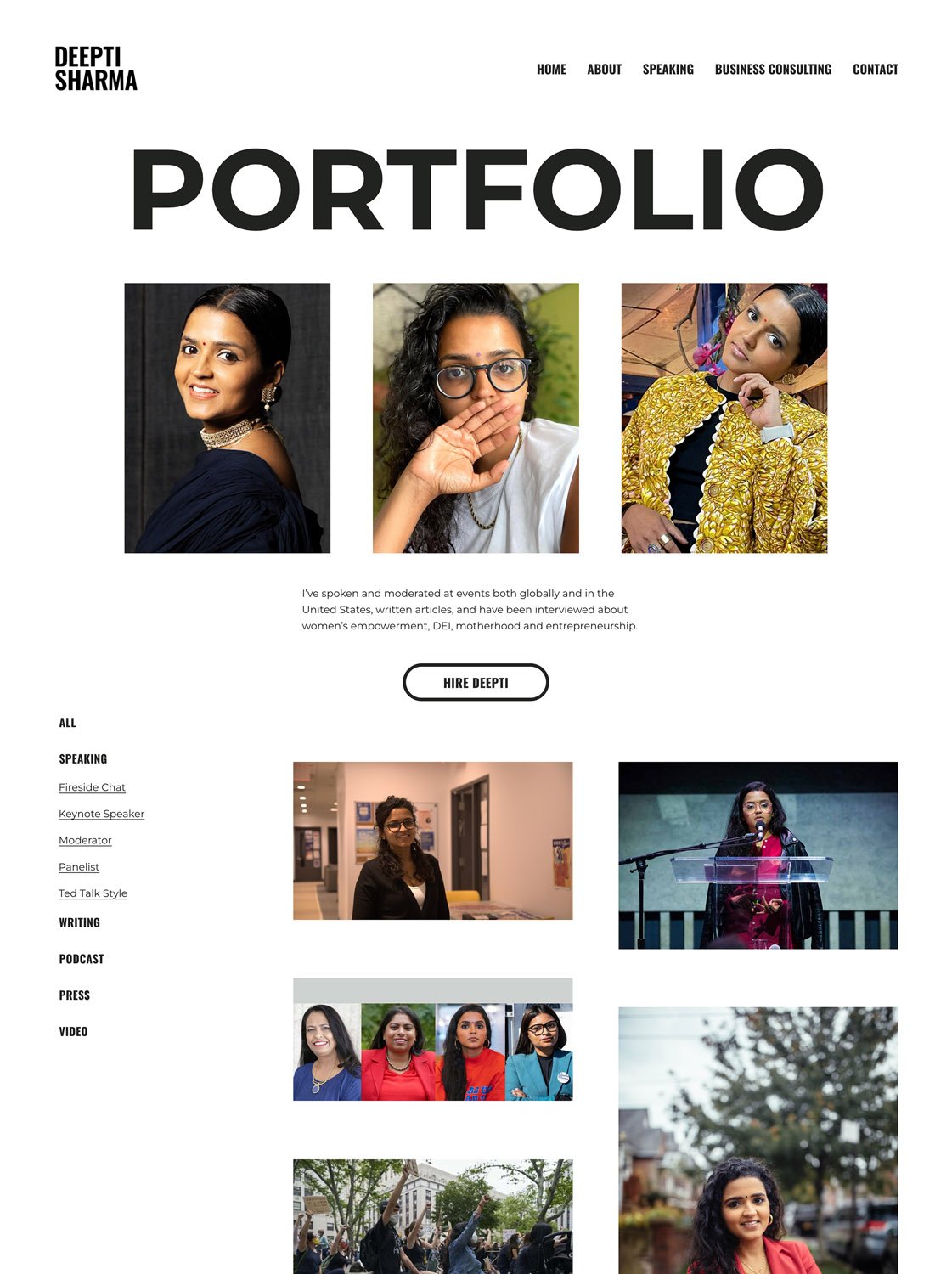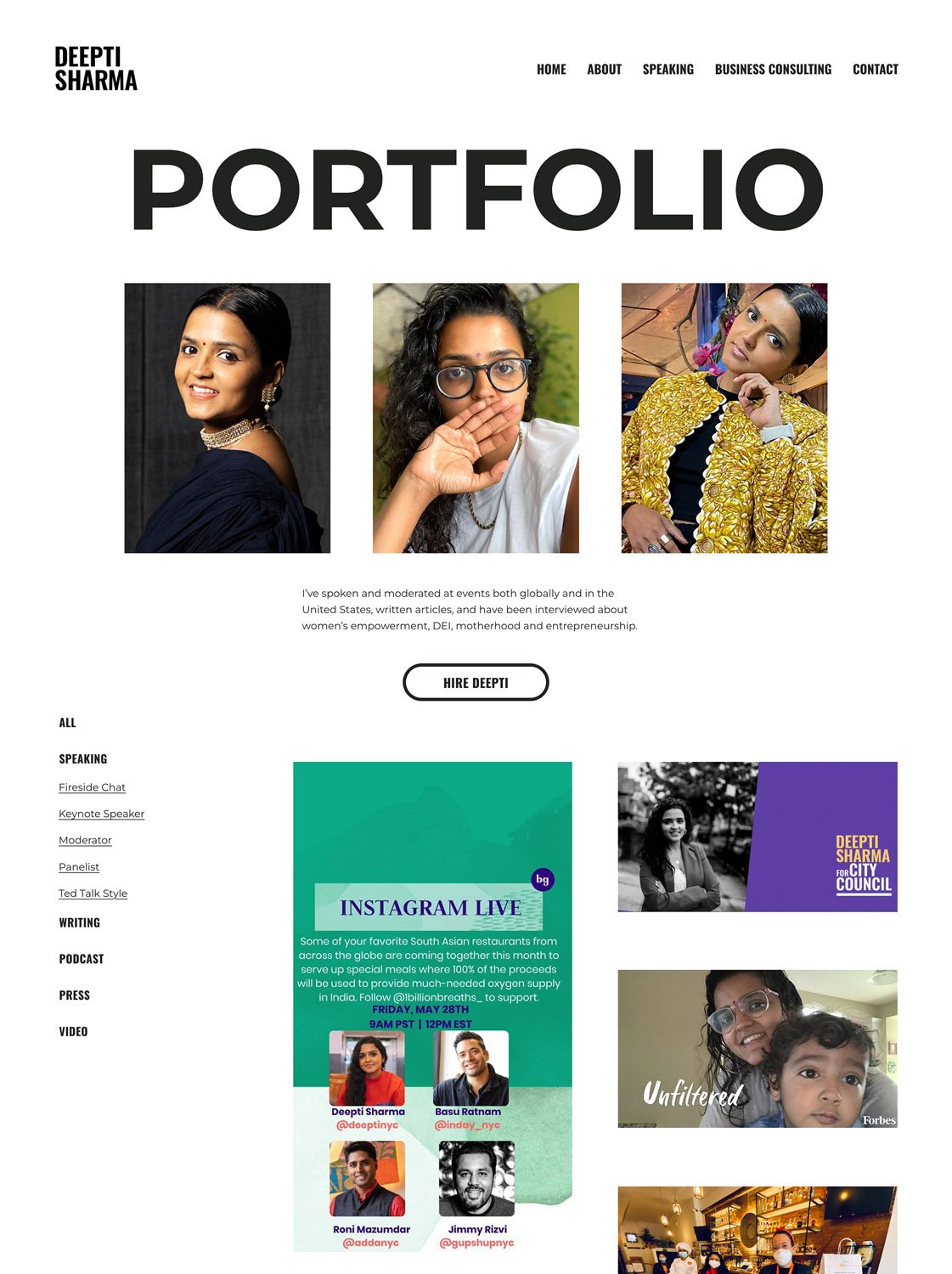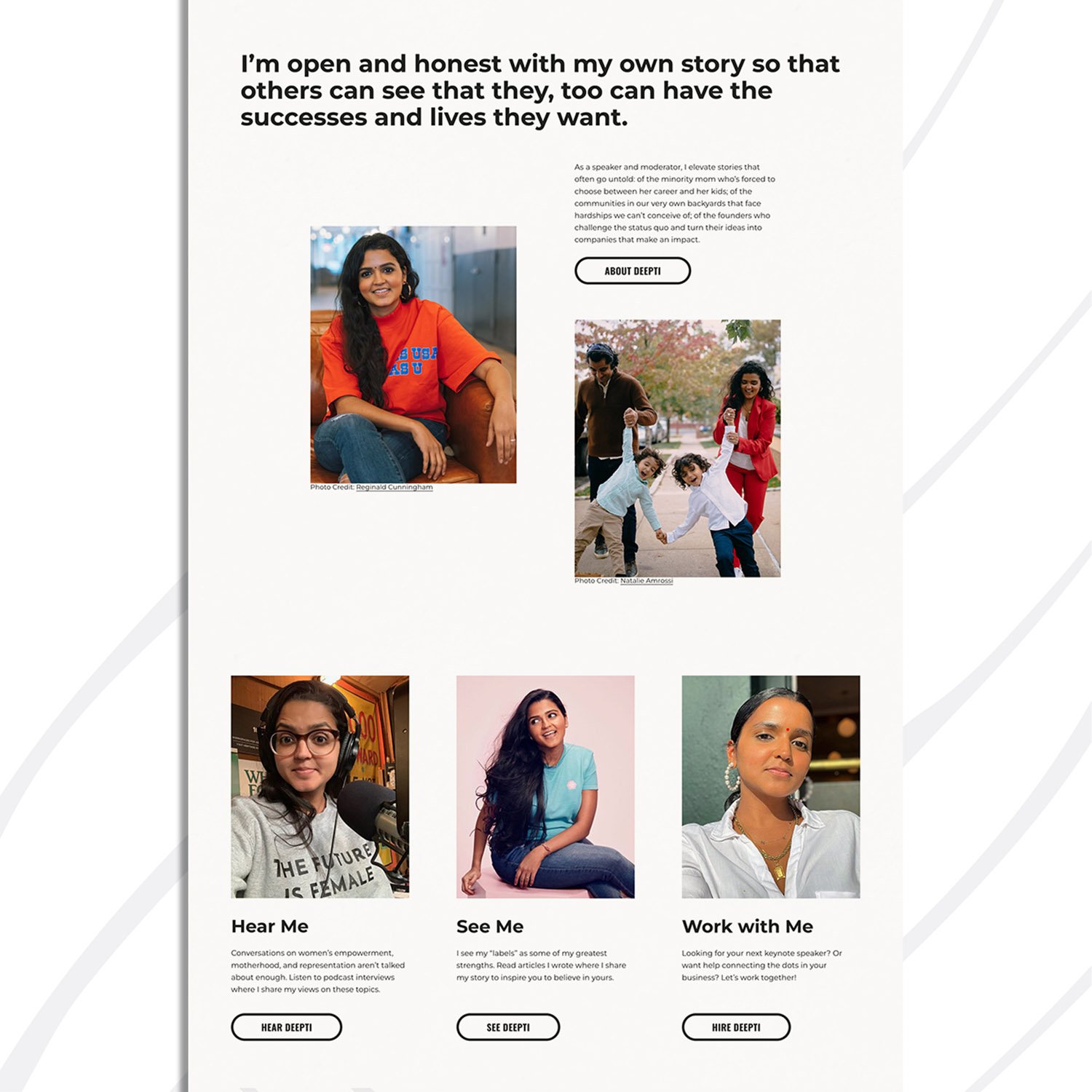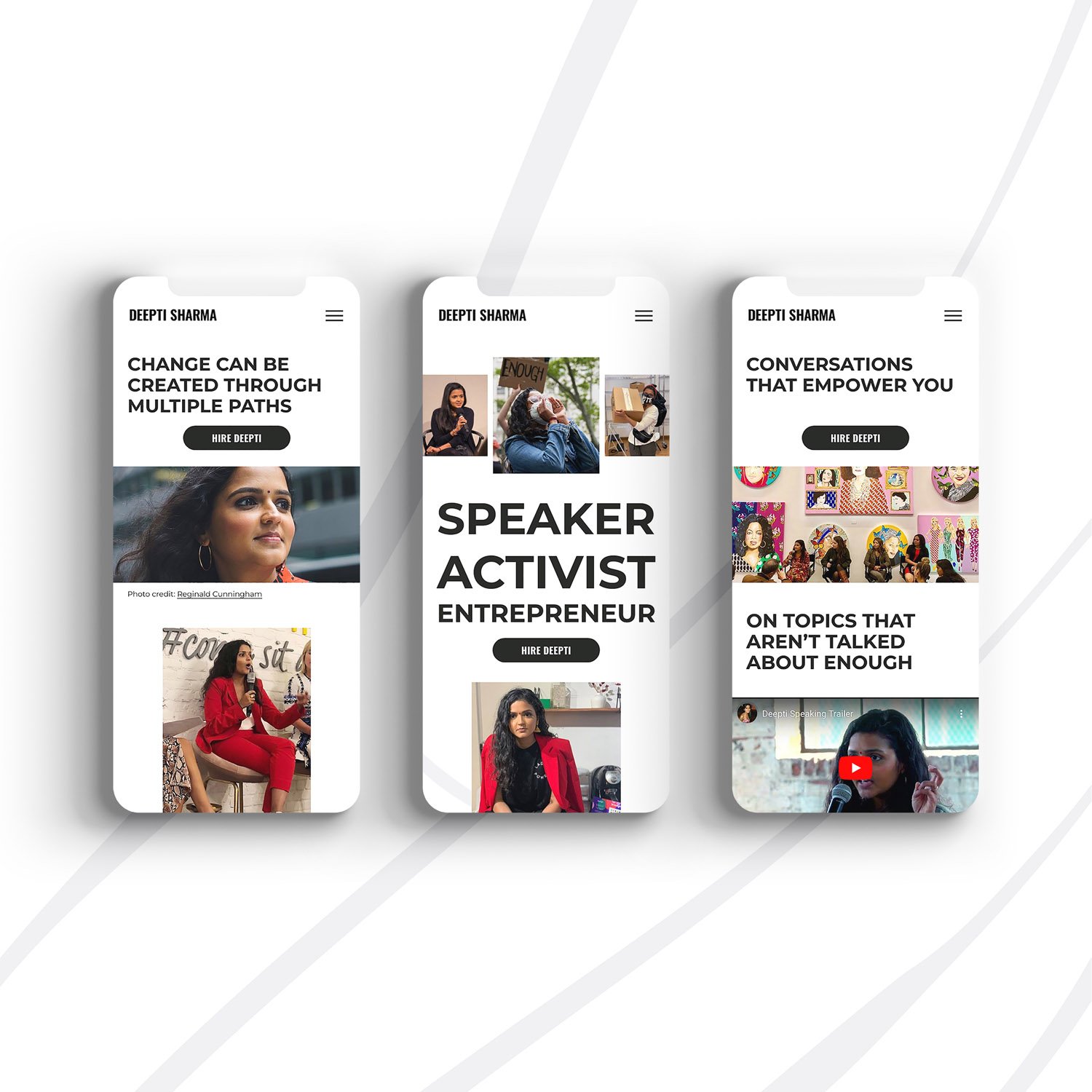Behind the scenes: Deepti Sharma’s website rebrand
Today on this IG live (originally posted on Instagram on May 3, 2023), we are going to talk about rebranding.
Before you freak out…A rebrand doesn’t mean scrapping everything you’ve already created in your business. A rebrand is perfect for when you want to lean into your strengths like if you’re pivoting. Or if you feel like your current website or your current visuals for your business don’t capture the moments or the evolution of your story. That’s why we are talking today with Deepti Sharma. I worked on her website rebrand because that’s what happened to her. If you don’t know Deepti, she’s a speaker, activist, and serial entrepreneur so let’s get started.
Jasmin Plouffe (JP): Hellooo!!!
Deepti Sharma (DS): Hiii!!!
JP: How are you?
DS: I’m good. How are you?
JP: Good. I feel like it’s been forever since we spoke to each other. We were going back and forth in text and emails. Now that we’ve launched, it’s like “Where have you been all my life?”
DS: I know. I know. It’s been a while. But I’ve been slowly trying to put content up and trying to launch stuff. So I’m excited to talk about it. When you suggested that we do this, I thought it was a great way! Because I know a lot of friends who are always working on their personal brands as they’re building whatever they’re working on. Whether they’re entrepreneurs or have a side hustle, it’s always great to have and maintain your personal brand…regardless of what you’re doing in life.
Meet Deepti Sharma
JP: Exactly! Before we jump into your brand vision and website rebrand, tell everyone about you. In case they don’t know who you are.
DS: Hi, I’m Deepti Sharma. Currently sitting in a hotel room. I don’t even know where to begin. Born and raised in Queens, New York.
A big component of my life is “How do I create impact in my community?” It started when I was a kid in middle school. Part of our curriculum was service learning. Every week, once a week, we would go to a school and work with disabled preschoolers for an hour. It was an awakening experience for me.
I think that’s where my journey of “How do I impact my community?” started. Because it was part of my school curriculum, I kept thinking “What comes after this?” I’m done with middle school. It’s been four years. Every week we were doing this, “How do I continue to create an impact?”
When I got to college, I thought it would be in politics. So I became a political science major. I worked on a number of different campaigns. In 2008, I graduated college during the recession. And thought “Ok, I’m going to go to law school, get my degree, and then go back into politics”. I was doing it for the knowledge. But somehow along the way, entrepreneurship became a part of my journey. That’s when I decided that you can actually create an impact by creating a company that provides for a community that has been overlooked.
That’s how I started my first company FoodtoEat. I was studying for my LSATs, waiting in line for a food truck, waited too long for the food. And it sparked that first idea “How do I create access to these food trucks and carts?” I’m a serial entrepreneur. I started two companies. My first one was FoodtoEat. The second one I started with my husband called Bikky.
I’m currently the Entrepreneur-in-Residence at Barnard and Columbia. And I’m always thinking about how to create impact and opportunities for communities that are often left out of the conversation. And aren’t invited to the table. That’s a little bit about me. Long-winded way of saying what the exact titles are. But I’m always thinking about impact, where it came from in me, and how I decided to put that forward.
JP: I love that service learning was built into your middle school curriculum. It feels like a novelty. I want to say. Because I didn’t have that in my school. Volunteer work was an extracurricular or a nice to have. Building it into the curriculum opens your eyes to what’s out there. And when you are introduced to it at a young age, it’s like how can you continue that momentum – which you clearly did.
DS: It was interesting because these were kids living in the same neighborhoods with similar socio-economic backgrounds as me. I was watching young kids – at the time, 10 years younger than me – having seizures. I was exposed to some hard truths in the world that were right in my community. Often times, people think “Oh poverty and hunger aren’t happening in America.” But in fact, they are. Until you’re actually paying attention, you don’t know. That was an integral part of this program. You saw it happen right in your backyard and you’re like “Oh I gotta do something”. Or at least it started to spark that in some people. I’m sure not everyone thought that. Some people were just like “Why are we doing this?” But it takes time for that to develop and to really understand the why behind the what.
What sparked the website rebrand?
JP: Exactly! And you had that at such a young age. Now that we redesigned your personal brand, why did you want to do it now? You’ve had such an in-depth career. You had 12 years of events, writing, and speaking engagements. So what sparked the website rebrand? What made you say “I want to spruce things up.”
DS: 2011 was when we launched the company. I started building it a few years before that. Every single time I was invited to speak, I was so grateful that somebody wanted to hear from me. I didn’t think I had a voice or something to say. I was so focused on creating my company – not my personal brand – that I didn’t realize I had a personal voice. My personal story was so attached to the work I was putting out there and doing. Maybe it was important to talk about it because it was all connected.
I started to notice other friends – who were founders – being invited to similar events. I started seeing them documenting, carrying around tripods, and recording themselves. They didn’t have big budgets or somebody following them. They had to create content themselves. Content creation is so different than it was back in 2011/2012 when I was starting the company. It’s quite interesting to see how much has changed.
I’ve always surrounded myself with founders who were important to me and helped me on my journey as an entrepreneur. And it wasn’t until some of them were like “Hey why don’t you have a personal page up?” I’m like how do you do that? I’m asking them like I don’t know how to build websites. I’m not an engineer. But I know, there were easy ways to do this. But I was acting like I didn’t know or probably wasn’t thinking about it for myself.
They were like just go on Squarespace, build a website, and document everything. I literally used one of my friend’s templates and copied exactly what she did. It’s Rhonesha Byng, from Her Agenda. She’s been such an amazing friend, who always shared along the way and never kept secrets to herself.
So I built a personal site by myself. It was literally everything I’ve ever done with no story behind it. There was a bio. But there was no talking about my past, present, and future. Or how everything is connected and what I really care about.
FoodtoEat took a big hit in 2020. All these changes happened and I was sitting last year thinking I did so much in just these past 3 years. I’ve run for office. I’ve fed half a million New Yorkers and none of that is captured nicely on my website.
We have known each other for a while and never worked together. I’ve always talked about the work that you've done. “I have a friend who designs really cool stuff!” I’ve always admired your work. So I was like who can I work with that knows me? Understand my ethos and energy…and is a branding expert.
While I know how to create branding, marketing, and messaging, it’s hard when you have to do it for yourself. That’s when I decided to step out of my comfort zone and say “Hey Jasmin, I’d like to hire you. I’m not asking you to do this as a friend. I need to hire you to help me create this next stage of what my personal brand looks like.”
Investing in yourself as an entrepreneur
JP: I love that you went through the journey and all the steps in creating your personal brand. Yes, you had your mentor who inspired you and you were able to start there. Then it gets to a point where you need to let go of the reigns and get outside help. You’re a very self-sufficient person. So I know you can do it. But when you don’t have the time and other things can be prioritized…that’s when you should lean on your team and ask for help so things go a lot faster.
DS: And also invest in yourself! So much of the time, we think “If I do it myself, then I can save money.” But sometimes it’s good to get out of your own head especially when creating a brand with a deep personal connection. And that’s why people hire me too. I do a lot of the strategy work. People hire me to help them look at their brand from an outside perspective. That’s what I needed. But again. People forget that you, yourself are a brand too. Yeah, I know how to talk about myself. I can do this. But that’s where your help was so nice. All the questions you started asking me. I was like oh wow…I didn’t even think about that for myself.
JP: It’s funny how we get kind of close-minded. We can do it for other people. But can’t actually do it for ourselves. So it's good to get that outside perspective.
DS: Yeah…Or it takes forever. And it doesn’t go anywhere.
What was creating your personal brand different from the branding you’ve done for your own companies?
JP: I’m doing my personal brand roadmap – which is what you get after we sit down and do your brand strategy session. And doing it for myself, I’m like why am I not done with this already? Because you keep prioritizing other things. What was it like creating your personal brand vs the branding you’ve done for your own companies? Was it different? Was it the same? Because now we are talking about you.
DS: It was definitely very different for sure. Because every single time, I’ve created a brand or helped others I’m looking at their customers and defining who they are. I’ve never met them. It’s all speculation of who you think your potential customers will be. Building customer profiles is part of the process. And having to do that for yourself was almost therapeutic. It was like a therapy session – to some degree – because you were asking very personal questions.
You asked about what I thought about certain things, my views, things I went through as a kid, and how all of those are connected to who I am as a person. So I felt like I was in a therapy session where I had to dig deeper. You said “Sometimes people get uncomfortable. If you don’t feel like talking about it it’s ok. I’m going to put these questions out there. If you want to come back to them that's fine.” So it was very different because of the way I had to work my brain and dig deeper.
I’ve run for office in the past few years and had to do it there as well. Everything about you is torn apart when you run for office. Everyone thinks you're a terrible person – at first – until you’ve built that trust and allowed them to trust you and understand who you are. All the interesting stuff you go through as a candidate.
But this was a similar process where I was soul searching. What makes me a good person? What makes me me? What makes me different? What makes me unique? Why would someone want to work with me? And hire me? And even when we created that prospective client who would hire me as a speaker or a strategist – who would come in and help with their branding, vision, and other stuff – why would they hire me?
Then you go through this imposter syndrome. It was nice to have you help me break that down. And say “Yes, look at all these things you’ve done. Now we just have to package them in a way that people understand.”
People have always known me for one thing. So allowing them to see that I’m not just the founder of FoodtoEat. I’ve started a second company. I’ve ran for office. I’ve fed New Yorkers. I’ve pivoted. I’m a child of immigrants and that’s part of my story. All of these things were important to think and talk about.
Not only did I have to do this with you, I had to do it with the copywriter, Maura Walters, you had introduced me. That was a whole other session of “How do I get her to put this into words?” I remember saying “Does this make sense? Do you understand what I’m saying?” “Yea yea yea just keep talking.”
What was it like to collaborate with a team to work versus doing it all yourself?
JP: I think that it’s true. Just keep talking. Just keep going through it. When you’re speaking to that expert – whether it’s a designer, copywriter, or marketing specialist – they want to know your story. Brain dumping usually doesn’t make sense to you. But to the other person receiving the information, it makes complete sense. They will see the connections and connect all the dots.
With Maura, it was great because after I did the brand strategy session with you, we handed your brand roadmap to her. She then took your vision and your dream client and kept them in mind while she took her specialty/expertise and ran with it. One thing she said was, “I didn’t picture Janis (your dream client) to look like this”. She was cool and edgy. So what was it like to have a collaboration, a team to work with versus doing it all yourself?
DS: I mean I absolutely loved it! I literally just recommended it. Once we started putting content out and sharing it, I kept talking about the wonderful experience. A collaborative effort always goes much further. When you’re building a brand, it can’t be just one person. You have to get the thoughts and perspectives of others.
You know what I always say to people building their own brand, do not create something without talking to the people you’re creating it for. Get different perspectives – I kind of needed to do that. You are both people who would potentially hire me for certain kinds of work. So I felt like I was also talking to potential clients and selling to the right demographic.
So for me, I love the collaborative effort! I love being able to get on calls with both of you. Hear your thoughts. Hear your criticism and feedback. Take that in and understand it. Again no matter how much of an expert you are in the space, I think it’s always good to build a personal brand with others to help you get that perspective you aren’t seeing about yourself. Sometimes people see things that you’ll never be able to see – which again is why we go to therapy or at least I do. I need that perspective. There are so many things you already know. But you don't know how to get it out there. You don’t know how to package it.
Having someone to create the words and the visuals was really nice. It gave me something that was not cookie-cutter. It wasn’t a template I pulled off Squarespace and looks like everybody else’s website. This was something more connected to me as an individual. I think your design work really showed that. We picked and looked through some different work that you put together. This felt connected. But also allowed me to step outside of my comfort zone.
The look and feel of the website today is not something I would have done on my own. I remember you gave me one that is exactly who I am. Then you gave me one that wasn’t exactly who I am and had a little bit of flair. I wanted to step out of that comfort zone. I wanted to break away from what I’ve always been known as. I wanted a little bit of loud but also a little bit of humility in the work I’m putting out there. So yeah, I really enjoyed the experience! I highly recommend it…especially the both of you!
The story behind the visuals
JP: When I showed you the two looks and feels you said “This is what I’m used to and this is what I’m not”. I had a proud mama bear moment when you said “Oh this could actually meet my ideal customer where they are at. It’s not scaring them away if they weren’t ready to make such a big change. It kind of eases them into who I am. Eases them into making more of an impact in their community.” And I was like “Yes!!! So excited!!!” You got to see that. You made that decision for yourself without me saying “Oh let's make sure we have your ideal client in mind.”
Your website definitely doesn’t feel out of the box or cookie-cutter. Which I’m so excited for. There’s so much behind your story that I didn’t want to take away from it. So we use a simple San serif font. Your brand colors are black, white, and grey because you have vivid imagery. Your words are so impactful that I didn’t want to distract or take away from them. So a more subdued background amplifies everything you’re saying.
Even the pattern I designed for you. My original inspiration was your voice and how it travels like sound waves. As I was drawing it, it also reminded me of a fingerprint which then connects back to you embracing your identity. So everything has a rhyme and a reason to it. And then adding white space – which isn't empty space, but breathability around each section. There’s a lot to take in from your story. And you want to give your viewer/client time to digest it all and see everything you bring to the table. With brand visuals, people think “Oh just do what you do and make it look pretty”. But no there are actual reasons and data behind it.
DS: Everything had that and that’s what I really enjoyed. You were able to look inside my story beyond the surface. And were able to look at every part of my identity woven into the work I do and why I do it. It’s not just what I do but there’s always a why – a reason why everything is all connected. Being a woman, being a person of color, being someone who identifies as a child of immigrants, and how that’s impacted me. I mean I got a tattoo with the year that my dad came to this country because it has made a huge impact on me. Weaving that into the visuals of my website was really important. While also remembering it is part of the story and putting it into words. All of that was awesome to see. I could see it even without you explaining it. People will start to acknowledge the work once they read the words.
Giving that white space felt really uncomfortable. Why is there so much white space? I was so used to filling up the page with stuff. It was nice to have something so different I wasn’t used to. And presenting it. People will always say “Oh my god, it’s so beautiful!” But I’ve had people go out of their way to say “Hey, I really like your website!” I’m not asking for opinions. I’m not reaching out to friends. People are saying “I really love the new look and feel!”
I can see a different excitement that I’ve never seen in the past with my template from Squarespace which I created on my own versus working with two professionals that are great at their job.
I also love working with women. I love the way we see each other in different ways. Maura is a mother. You being a mixed race and your background and your identity. That was really important for me to have someone who understood the different identities and labels. And not only listen to me but live the experiences to some extent. You and I have talked about it from the day we met. Being of mixed race growing up in a predominately white neighborhood for you. And talking to Maura and getting to know her too. Which was very different because she was new to me. And for you as well. So it was cool to get to know people along the way and say “Yeah, this kind of works. It has its own synergy.”
JP: It’s not just hiring someone to do the work for you. It’s really connecting and learning about them. It builds those stronger – it makes everybody more excited and passionate about the work we’re doing and putting out into the world.
Key Takeaway from Deepti Sharma
DS: Absolutely! I hope this inspires other people to invest in themselves. A lot of times, we are too afraid to say “I need to spend X thousand dollars in creating my brand.” No, it’s important. If the message you are creating is important, the way it looks, and the way it gets out there is also important.
If you look at every movement, even just on a social or political level, everything is a campaign. Everything has colors and brands. When we look at the marriage act and all the work that has gone into it. It’s a lot of branding and messaging that was really important. It wasn’t just people just going out and protesting. Everything had a place. The activist side of me thinks it’s really important and that we all need to think about it.
Every program, every movement thinks about how they are perceived and how they are being viewed. So whether you are an entrepreneur or a speaker who is just talking about your story and your experiences, or you’re an activist…it’s really essential to think about how you invest in yourself, how you show up for yourself, and tell that story in the right way.
JP: I love that! So let’s wrap everything up. I know we stayed a little long. How can everyone connect with you or work with you? What’s on the table right now for you with your offers?
DS: I would love to help anybody working on their own company and help them strategize. I love companies at the very entry level when everything is so exciting and confusing all at the same time. I bring in a good perspective and build a strategy for the next 6-18 months.
You can find me at my website deeptisharma.com and deeptinyc on all social. And everyone that has worked with me on creating the website is on the website. If you go to the bottom, you can find Jasmin. You can find Maura. You can find Terica Walton who created the logo when I was running for office. It was really important for me to acknowledge everyone who was part of the village that created the website.
I’m ready to speak, be on those stages, and tell my story. But also tell other people’s stories. Everything is on the website. So go there first.
JP: Yayyy! Definitely follow Deepti. I’m telling you she does amazing stuff. Always putting herself out there, encouraging confidence, and trying to make that impact. Even if it feels small, make that impact you got it. Thank you Deepti! I appreciate you showing up today.
DS: Thank you for having me!




